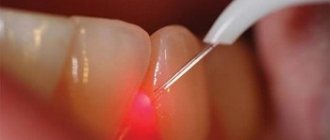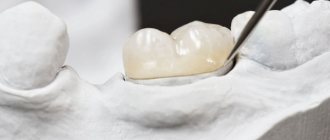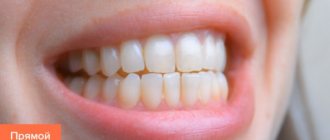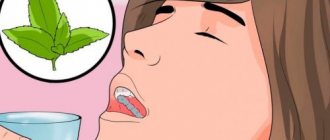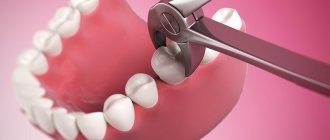595
Removing diseased teeth has always been considered a simple and effective way to get rid of the pain and discomfort they cause.
The development and manufacture of instruments for this operation was an equally important task. The first document containing information about the use of special instruments for tooth extraction dates back to the 17th century BC.
The papyrus contained images of a device similar to forceps, which could presumably be used to remove teeth.
The ancient Indian healer Sushtra divided tools for tooth extraction into forceps and special levers. The latter can be considered the prototype of modern elevators.
General overview
A dental elevator (lat. Elevator - lifting) is a hand-held dental instrument designed to remove dental roots and/or dystopic teeth by loosening and turning them out.
In terms of its action, the elevator is a classic lever and consists of 3 elements:
- working part (cheeks);
- pens;
- a long, narrow element connecting the cheek to the handle.
The cheek has the appearance of a convex-concave groove of oval, rectangular or spear-shaped. It can be symmetrical or asymmetrical, directed at different angles to the connecting part, with a mirror reflection or not.
A wide variety of shapes of the working part and its positions relative to the handle and connecting rod allows you to select an instrument that is optimally suited to perform the task facing the surgeon.
Elevators are made of chrome-nickel-molybdenum steel. Requirements for the composition and quality of the alloy are regulated by GOST 30208-94 (ISO 7153-1-88) and R 50328.1-92 (ISO 7153-1-88).
For the manufacture of elevators, steel grades B, C or D (20X13, 30X13, 45X14) are used. Tools made by powder metallurgy have the best quality. Fine steel powder containing alloying additives is pressed into a mold and sintered.
Features of tooth root removal: how the operation works
Tooth root removal is considered one of the most unpleasant dental procedures. This is true if the patient visits the dentist once every few years, while choosing municipal clinics. Dentistry has advanced a long time ago, and if you treat your teeth in a clinic with modern equipment, there is no reason to be afraid of pain and consequences.
A root damaged due to improper treatment or injury may cause discomfort or pain to the patient For a long time, the patient feels discomfort if the root remains after a tooth has been removed. It seems as if something is in the way. There are rare cases when the remaining root does not make itself felt for a long time. It can only be detected after the patient takes an x-ray.
Most people neglect the existing problem and categorically refuse to go to the dentist. This often leads to complications.
Types and purpose
Depending on the shape of the cheek and its position relative to the connecting part, the following main types of instruments are distinguished:
- straight;
- bayonet-shaped;
- angular.
The bayonet-shaped design is a subtype of the straight one. In addition to the above types, there are also special tools designed to perform more specific tasks , in particular, elevators for removing individual root fragments, wisdom teeth, etc.
Many instruments belonging to one of the above groups bear the name of their developer - Lecluse, Vint, Barry, Pott.
For what purpose is the wound filled with alvostasis with a sponge after tooth extraction and what effect does the drug have?
Come here to find out in what cases socket suturing is performed after tooth extraction.
At this address https://www.vash-dentist.ru/hirurgiya/udalenie-zubov/stomatologicheskogo-shovnogo-materiala.html you will find an overview of suture material for dental surgery.
Straight
The working and intermediate parts of a straight elevator are located in a straight line. The cheeks can be rectangular, oval or bayonet-shaped. Their edges are usually thinned and pointed. Some have notches that increase the adhesion strength to the root being removed.
Direct elevators are used primarily for removing dental roots and dystopic teeth, including maxillary 3rd molars.
The most famous straight design was developed by Lecluse, and bears his name. The most notable features of the Lecluse elevator are the handle, attached at right angles to the connecting part, and the bayonet-shaped cheek.
In appearance, Lecluse's instrument resembles a corkscrew. Due to its considerable length and power, it is used for extraction of lower “eights”.
Angular
The peculiarity of the corner elevator is that the spoon bends in relation to the connecting part at an angle of approximately 120 °C. This makes it convenient to create leverage on the roots of teeth in various directions.
The bend can be with a right or left turn (“away from yourself” or “towards you”). The spoon may be jagged and its shape is usually oval or spear-shaped.
The corner elevator is most often used to remove individual roots and dystopic teeth. In this case, the convex part rests against the wall of the hole, and the concave part is directed towards the root to be removed.
Angular tools include Winter, Barry, and Pott elevators. All of them have a handle located perpendicular to the connecting part. These are powerful tools that allow effective luxation (Latin luxatio - displacement, dislocation) of the root and subsequent removal.
Bayonet-shaped
The bayonet elevator is a straight elevator. Its cheek is shaped like the tip of a spear, one side is smooth, the other is convex.
An example of using a bayonet-shaped instrument: with a completely destroyed crown of the 1st molar and a thick interradicular septum, it is used to separate the roots and dislocate and remove them separately.
The Lecluse elevator, which also belongs to the bayonet type, is used to remove third molars on the lower jaw. Its length and power are quite sufficient for this task.
However, you need to act carefully, since there is a danger of dislocation of the neighboring teeth on which the instrument rests.
To remove root fragments
To remove separated roots or fragments thereof, it is convenient to use instruments with very thin cheeks, sometimes located on both sides of the instrument and in different directions to each other (“away from you” and “towards you”). The surgeon holds such an instrument in the “writing pen” manner.
Tooth extraction using an elevator
Application of elevators
based on the use of the principle of leverage. Several designs of these instruments have been proposed. Of these, straight, angled and bayonet-shaped elevators are widely used.
Method of tooth removal using an elevator
boils down to the following. The thumb and forefinger of the left hand grasp the alveolar process, and with the right hand, forcefully insert the working part of the elevator into the periodontal gap of the tooth being removed, which, acting like a wedge, expands the periodontal gap and breaks the periodontal fibers. At the same time, rotational movements are made by the elevator. After inserting the end of the elevator by 0.4-0.6 cm, it acts as a lever of the first kind with a fulcrum in the region of the edge of the alveoli. The doctor’s force, transmitted to the end part of the elevator—the cheek—causes the tooth to be squeezed out of the alveolus. A straight elevator is used in a similar manner to remove impacted and semi-impacted third molars. When removing upper and lower large molars, it is advisable to first separate the roots using a chisel or fissure bur. Then, using the method described above, one of the dissected roots is removed using a direct elevator. The remaining roots can be removed using bayonet-shaped forceps with narrow converging cheeks on the upper jaw or root forceps or angled elevators on the lower jaw.
WOUND TREATMENT AFTER TOOTH EXTRACTION
Extracted tooth
, the root must be carefully examined and made sure that they are completely removed. Then they begin a visual and instrumental examination of the hole. Using a small surgical spoon with sharp edges, the walls of the socket are first examined. Loose bone fragments and tooth fragments are removed, the protruding edges of the socket are removed with pliers and smoothed with a spoon. After this, the bottom of the hole is examined - the granulation tissue present there is scraped out, since the remaining granuloma can subsequently lead to the development of a cyst. However, in the area of the upper molars, it is better to refrain from scraping the bottom of the socket due to the risk of perforation of the bottom of the maxillary sinus.
Curettage of granulation tissue
should be done carefully in the area of the lower molars. This is due to the fact that the pathological process sometimes destroys the bone bridge between the bottom of the socket and the wall of the mandibular canal. Deep curettage of tissue in such cases may be accompanied by a violation of the integrity of the neurovascular bundle. After revision of the sockets, the gums in the area of surgical intervention are examined and, if there are gaps, sutures are placed on the edges of the wound. Then a gauze ball is placed on the alveolar edge of the jaw in the area of the extracted tooth, with the help of which the edges of the socket are compressed, as if bringing them together. The patient is asked to bite the ball and hold it for 15-20 minutes. If there are no signs of bleeding after removing the gauze ball, the patient can be released. To prevent the destruction of a blood clot in the socket, he is recommended not to eat for two hours, not to smoke, to refrain from eating hot food, rinsing the mouth, to avoid sudden physical stress that causes an increase in blood pressure, and not to lick the tooth socket.
COMPLICATIONS DURING AND AFTER TEETH EXTRACTION
During tooth extraction
Violations of the patient’s general condition and local complications may occur. The first include fainting, collapse, breathing problems up to asphyxia, caused by the entry of an extracted tooth, tampon, or blood clot into the respiratory tract. Complications of a local nature: fractures of the tooth, alveolar process, fracture and dislocation of the lower jaw, advancement of the tooth into the perimaxillary soft tissues, perforation of the bottom of the maxillary sinus, bleeding.
Important nuances when working with the tool
The success of elevators in root removal depends critically on the correct choice of tool and its proper use.
Before choosing a tool, a careful examination of the root and tooth to be removed is carried out. First of all, the strength of the crown is assessed, whether it can withstand the pressure of the forceps.
If there is reason to doubt this, select an elevator design that best suits the task ahead. To prevent the crown from interfering with work, it is bitten off.
Methods of using elevators depend on the severity of the bend of the roots being removed:
- If the curvature is insignificant , the root is deflected with the tool towards the curved side, applying the load in the direction of greatest compliance. This causes the socket to enlarge and the tooth to dislocate.
- If the roots of the 3rd molars are curved medially , the crown is sectioned, an elevator is inserted from the distal side, the crown is shifted distally and removed.
- If the medial and distal roots are bent in different directions , the tooth is divided into three parts, an elevator is inserted from the side opposite to the root being removed, and the distal and medial roots are shifted in the direction of the bend. After the periodontal ligaments have ruptured, the root is removed.
- When the root is bent in the lingual or buccal direction, the elevator expands the periodontal gap in the plane of the root bend and removes it.
- Premolars with a completely destroyed crown and a significant thickness of the alveolar process are removed by inserting cheek counters between adjacent teeth and the roots of the premolar.
- Direct elevators are advisable to use when removing wisdom teeth , especially if the clinical picture is accompanied by a problem with opening the mouth. The working part is located along the medial buccal surface of the figure eight.
Serious attention should be paid to sterilization of instruments. If disinfection is insufficient, transmission of infection is possible both from doctor to patient and from patient to doctor.
There is a certain method for sterilizing dental instruments, which involves performing several successive operations: soaking in an antiseptic solution, rinsing with running water, immersing in a biosol solution heated to 40°C, drying in the open air.
Easy Graft bone replacement material and its features.
In this publication we will tell you whether supernumerary teeth are always removed.
Here https://www.vash-dentist.ru/hirurgiya/udalenie-zubov/vse-tonkosti-lazernogo.html let’s take a closer look at the method of laser tooth removal.
Elimination Features
To eliminate a damaged tooth, an elevator is inserted between the wall and the root; for multi-rooted units, between the individual elements of the root. The concave side faces the tooth, the convex side faces the socket. The doctor presses on the handle and forgives the instrument, moving its working part deeper. The success of removal depends on how correctly the dentist chooses the type of instrument and performs the operation. Before starting work, you need to carefully examine the damaged and removed tooth and evaluate the strength of the crown part. If the external crown is in the way, its preliminary removal is indicated.
Elevator usage options:
- With slight bending, the root part is deflected, the socket is enlarged, and the unit being removed is dislocated.
- For third molars, sectioning and insertion of the cheek from the distal side are necessary. The dental crown is displaced and the units are removed.
- If the roots are sufficiently bent, it is necessary to rupture the periodontal ligaments. To do this, the tooth is divided into three separate parts using special tools, which are removed one by one.
- In case of buccal as well as lingual curvature, the elevator widens the periodontal gap, after which removal is carried out.
- If the alveolar process is of significant thickness or the crown is significantly destroyed, the cheek is inserted between the root part and adjacent units.
- The straight type of instrument is used to extract figure eights; the working part is carefully inserted along the surface of the tooth, after which it is removed.
Before starting the procedure, you must thoroughly sterilize the elevator and other instruments. First, they are soaked in an antiseptic solution and washed in clean running water. The next step is immersion in the biolot, heated to 40 degrees. The instruments are dried before use.
Possible complications
Although complications from tooth extraction using an elevator are relatively rare, they are not only possible, but some of them can be quite serious.
Surgical dental practice notes the following complications when using elevators:
- Bleeding due to damage to large vessels.
- Damage or removal of the rudiments of permanent teeth when removing “milk jugs,” in particular, the follicle of wisdom teeth. This is facilitated by the interdental septum, which is elastic and adapts to the changeable bite.
- A puncture wound on the cheek of the tissue adjacent to the tooth being removed. The development of bleeding is dangerous if a large vessel has been damaged, for example, a branch of the carotid artery.
- Infection of a patient with a poorly sterilized elevator, development of alveolitis.
- Luxation (rupture of the periodontal ligament) of adjacent teeth due to improper use of the elevator.
- The tip of the instrument breaks off and gets stuck in the wound.
- Alveolar bone fracture. Can occur when removing buccal or medially curved roots - in cases where the load on the instrument is applied to the tips of the roots.
In dental practice, a curious case was recorded when, a month after successful tooth extraction, a granuloma formed in the area adjacent to it.
After its removal, a piece of the dental surgeon's nail was found in it, which was cut off with an elevator during root removal.
The video provides additional information on the topic of the article.
Method of tooth removal using an elevator
The method of removing teeth using an elevator comes down to the following. The thumb and forefinger of the left hand grasp the alveolar process, and with the right hand, forcefully insert the working part of the elevator into the periodontal gap of the tooth being removed, which, acting like a wedge, expands the periodontal gap and breaks the periodontal fibers. At the same time, rotational movements are made by the elevator. After inserting the end of the elevator by 0.4-0.6 cm, it acts as a lever of the first kind with a fulcrum in the region of the edge of the alveoli. The doctor’s force, transmitted to the end part of the elevator—the cheek—causes the tooth to be squeezed out of the alveolus.
A straight elevator is used in a similar manner to remove impacted and semi-impacted third molars.
When removing upper and lower large molars, it is advisable to first separate the roots using a chisel or fissure bur. Then, using the method described above, one of the dissected roots is removed using a direct elevator. The remaining roots can be removed using bayonet-shaped forceps with narrow converging cheeks on the upper jaw or root forceps or angled elevators on the lower jaw.
Tooth extraction is an unpleasant but necessary process. And in order to maintain your mental health, you just need to close your eyes during the procedure. If you can’t see something metallic-threatening being directed into your mouth, then you may not notice any discomfort.
A visit to the dentist forces a person to get up close and personal with a variety of instruments, often more reminiscent of a torture kit from the Inquisition than devices for medical manipulation. But everything is not as scary as it seems. The intimidating form of dental instrumentation is designed to ensure the safest and most effective procedure possible.
Reviews
Elevators are used in cases where extraction of a tooth or root for some reason (most often due to destruction of the coronal part) cannot be performed with forceps.
Despite the fact that this operation is considered more complex, the patient, thanks to anesthesia, in most cases does not experience any more discomfort than when removed with forceps.
If you had your teeth removed using an elevator, tell us what sensations this was accompanied by, were there any complications during wound healing? The comment form is located at the bottom of this page.
If you find an error, please select a piece of text and press Ctrl+Enter.
Tags: tooth extraction
Did you like the article? stay tuned
Previous article
Icone infiltration system or “liquid filling” for teeth
Next article
What is odontoma, how dangerous is it?
REMOVAL OF TOOTH ROOTS AND TEETH BY ELEVATORS
Elevators are used in cases where it is impossible to remove tooth roots, and in some cases even teeth, with forceps. Most often this happens when the root is located deep in the hole. The use of forceps in these cases is often accompanied by significant damage to the mucous membrane and bone tissue of the alveolar process, but it is still not possible to capture the root. Intervention with an elevator is less traumatic. Sometimes removing the lower third molar and teeth located outside the dentition (especially on the side of the hard palate) is easier to do with an elevator than with forceps.
What complications may arise?
- An inflammatory process may develop due to a chronic source of infection, which occurs if the cause of tooth decay is caries. Inflammation of the gums can cause periodontal disease and then the inflamed and infected hole will take a long time to heal.
- If tooth decay occurs as a result of injury , then infection of the wound surface may occur. Therefore, the remainder of the root must be urgently removed, and the damaged socket and gum must be sanitized.
- a pathological process develops due to the presence of part of the root in the thickness of the bone.
